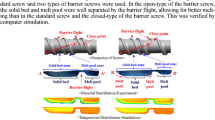Abstract
For such conditions that (H/R0)2 is replaced by ε (that is the order of 10-1) and\(\hat \theta ^2 \) is the order of one, the rule of thumb for an approximated flow model was introduced in part 1 of the paper to show, in qualitative way, whether the resistance of the relatively thick cavity of two square plates might affect the gas direction in GAIM under the aforesaid geometry. Subsequently, various simulations were performed by using Moldflow (version of MPI 4.0) under the conditions that all dimensions of cavity of two square plates and pipes were fixed except for the diameters of pipes, and the results of simulation were compared with the results of a rule of thumb (RT1) containing the approximated flow model as well as those of another rule of thumb (RT2) without the resistance of the relatively thick cavity of two square plates. There were some exceptional cases where RT1 or RT2 were not consistent with the simulation results (i.e., flow directions). Thus such a developed model as time-dependent model was required to describe transient behavior of the interface between gas phase and resin phase instead of comparison of initial velocities in upper side and lower side of the configuration, which was proposed and utilized to compare with the results of Moldflow in this 2nd part of the paper. The predictions of the developed flow model were so quite consistent with the results of simulation that the proposed time-dependent flow model may be referred to describe very well the transient behavior of the movement of the interface of gas and melt-resin in the cavities. In addition, a timedependent model was also established and was used to compare with the results of Moldflow when cavities of pipes and runners were involved in configuration. It is amazing that the proposed developed model was able to predict exactly the cross-over between the trajectories of interface of upper and lower side, and it is also surprising to describe the time dependent behavior so well that the result of the predictions by the developed model were quite consistent to the results of simulation by Moldflow.
Similar content being viewed by others
References
Lim, K. H., “Flow Direction when Fan Shaped Geometry is Applied in Gas Assisted Molding: 1. Theory of Flow Model and its Criterion to Predict Flow Directions”,Korean J. Chem. Eng.,21, 48 (2004a).
Lim, K. H., “Gas Flow Direction under Heterogeneous Geometry Composed of a Pipe and a Cavity of Two Square-flat Plates in Gas Assisted Injection Molding,”Journal of Industrial and Engineering Chemistry,10(3), 416 (2004b).
Lim, K. H., “Flow Directions in Gas Assisted Injection Molding when Cavities of Square Flat Plates and Pipes are Involved: 1. Theory of Flow Model and its Criterion”,Korean J. Chem. Eng.,21, 1108 (2004c).
Lim, K. H. and Hong, S. H., “Flow Direction when Fan Shaped Geometry is Applied in Gas Assisted Molding: 2. Development of Flow Model and its Predictions”,Korean J. Chem. Eng.,21, 59 (2004).
Lim, K. H. and Lee, E. J., “Predictions of Gas Flow Directions in Gas Assisted Injection Molding When Cavities and Runners are Involved”,Korean J. Chem. Eng.,20, 592 (2003).
Lim, K. H. and Soh, Y. S., “The Diagnosis of Flow Direction under Fan Shaped Geometry in Gas Assisted Injection Molding”Journal of Injection Molding Technology,3, 31 (1999).
Soh, Y S., “Control of Gas Direction in Gas Assisted Injection Molding,”Journal of Reinforced Plastics and Composites,19, 955 (2000).
Soh, Y S. and Lim, K.H., “Control of Gas Direction in Gas Assisted Injection Molding: Definition of Resistance to Velocity, r-v,” SPE ANTEC Tec. Papers,60, 482 (2002).
Author information
Authors and Affiliations
Corresponding author
Rights and permissions
About this article
Cite this article
Lim, KH., Hong, SH. Flow directions in gas assisted injection molding when cavities of square flat plates and pipes are involved 2. Development of time-dependent flow model. Korean J. Chem. Eng. 21, 1126–1138 (2004). https://doi.org/10.1007/BF02719484
Received:
Accepted:
Issue Date:
DOI: https://doi.org/10.1007/BF02719484




